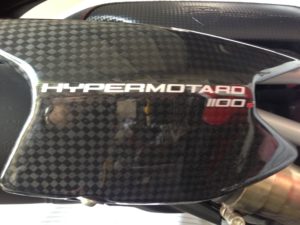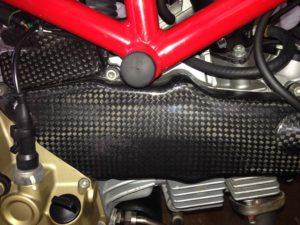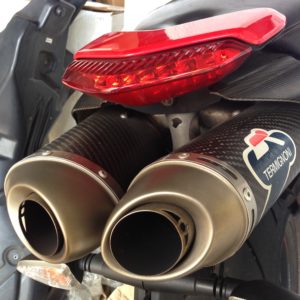As I stated in my last post, water is my favorite inorganic molecule! It is so simple, yet it has extremely unique properties. For example, as you well know, ice floats in liquid water. However, that’s not the case for the solid vs. liquid forms of most substances, inorganic or organic. Why’s that? Well, it goes back to the physical property of density. The density of solid ice is less than that of liquid water because the amount of molecules that are “packed” into a certain amount of space is less for ice than for liquid water; that makes ice less dense, and it floats. (Thank goodness, as there would otherwise be no ice-skating on frozen lakes and ponds in the winter.)
But that’s enough about ice; brrr! We don’t want our motorcycles’ engines to be quite that cold, but we do want them to be kept cool so that they don’t overheat while we are at idle or while touring, commuting, racing, etc.
In general, engine cooling occurs in one of two ways, air or liquid cooling. The vast majority of modern sport and race bikes are liquid cooled, with the most common liquid being (you guessed it) water! (Well, it’s not usually pure water, but we’ll touch on that shortly.) There can be some disadvantages to water-cooled engines. In brief, there are more parts to leak or fail, such as hoses and water pumps that are needed to keep the water circulating around the outside of the cylinders and cylinder heads (in the “water jacket”). Nevertheless, water is plentiful and it has another fabulous physical property that is unique in comparison to other similar molecules. It has a very high specific heat capacity.
A high what? It’s okay if you aren’t familiar with this term. It’s fairly simple to understand. Specific heat capacity is how much heat energy a substance must absorb to raise one gram of that substance by a single degree Celsius. Looked at another way, if a substance has a high specific heat capacity, then a one degree temperature change results in more heat being absorbed for the same amount of material, compared to a substance with a low specific heat capacity. For example, it takes about four times as much heat energy to raise the temperature of a gram of water from 20-21°C (or from 45-46°C), as it does to effect that temperature change for a gram of aluminum or air. Aha! While air has the advantage of being all around your engine, it can’t absorb the amount of heat energy that water can to keep your engine within a safe operating temperature. And air only circulates if you are in motion or it’s windy. That’s not so great out in the desert as you are idling and waiting for your rally race to begin.
Speaking of desert riding, there are both hot and cold temperature extremes in which even our fantastic water molecule can’t do its job. At 100°C, water boils and at 0°C, it becomes ice. So, that’s where anti-freeze comes in handy. In fact, anti-freeze (often, but not always, the compound ethylene glycol) when mixed with water actually lowers the freezing point and raises the boiling point. That’s a pretty “cool” effect. The chemistry behind these physical changes of the properties of the mixture compared to pure water has to do with the general principal of “colligative” properties of substances.
[You can learn more about that at the HyperPhysics site,
http://hyperphysics.phy-astr.gsu.edu/hbase/Chemical/collig.html]
When I asked my husband why it took him almost 30 years before he owned a water-cooled bike, the answer was basically due to the simplicity of the air-cooled engines. In fact, his first water-cooled motorcycle had a water pump failure while we were riding California’s Highway 9 through the Santa Cruz Mountains. So, why did he encourage me to purchase a water-cooled motorcycle as my second ride?
Well, I wanted more horsepower for street riding, which meant that I needed an engine with either a greater displacement or one of similar displacement that could run a higher compression ratio. I chose the latter, and that required it to be water-cooled, due to the higher engine operating temperature. I was happy. I had a bike with similar size and weight, but I could get more “bang for the buck”.
It’s still true that air-cooled engines are simpler to maintain if you are a do-it-yourself kind of person. But if you have a good mechanic, or your own shop, then why not give water-cooling a try?
Speaking of mechanics, my next post will feature a guest co-host and former student of mine who is a certified motorcycle mechanic. We’ll be talking brake pads. Oh, stop!



